Nepali Food Dal Bhat Tarkari
In the Nepalese tradition, Dal Bhat is one dish that is most synonymous with home and the Nepalese people’s heart-warming hospitality. This meal is not simply about what one eats; it also represents custom, sustenance, and fellowship. Daily, millions eat Dal Bhat – lentils (dal) and rice (Bhat), which gives a glimpse of the colorful Nepali food culture.
From the bustling streets of the capital city, Kathmandu to the serene Himalayan countryside, the humble communities of Nepal indulge in Dal Bhat. It also cross-cuts class and region, bringing together families and friends at the dining table for dinner. The main course is usually accompanied by different types of vegetable curries, pickles, and occasionally a meat or fish dish. Each one complements the other and emphasizes the local produce that the Nepalese cuisine is famous for.

Of even greater value, however, is the role that Dal Bhat plays in Nepali culture. Apart from its nutritional value, it is a dish usually served in a manner that promotes sharing among those who take it. Originally hand-rolled and associated with eat-from-hand, it encourages people not only the tastes but also the feel of bonding over a meal.
Which brings us to Dal-Bhat, or rather, more to the spirit of Dal Bhat, which is not just about food, but also about pride, tradition, and the spirit of the Nepali people. In the next couple of sections, we will explore what Dal Bhat is made of, how it is cooked, and the variety that is unique to the Nepalese cuisine.
Understanding Dal Bhat Recipe
Dal refers to lentils, which are cooked and seasoned with various spices. It serves as a rich source of protein, especially for vegetarians, while also being a great source of fiber, iron, and various vitamins. Common types of dal include red lentils (masoor), split yellow peas (toor dal), and maas ko daal (Nepali Kalo Daal).
Bhat translates to cooked rice and serves as a staple in many South Asian diets. Rice is not only filling but also provides essential carbohydrates and energy. Typically, it is served plain or flavored with spices and herbs, depending on regional preferences.
Most Common Types of Dal You Can Find In Nepal
- Moong Dal (Split Mung Beans)
- Masoor Dal (Red Lentils)
- Maas Daal (Nepali Black Dal)
- Toor/Tuvar Dal (Pigeon Pea)
- Chana Dal (Split Bengal Gram)
- Moth Dal (Matki Beans)
- Rajma (Kidney Beans)
Aromatic Ingredients For Dal(Lentils)
- Lentils (Dal): 1 cup, choose any type of Dal.
- Water: 3-4 cups, for cooking and consistency.
- Turmeric Powder: ½ tsp, for color and health benefits.
- Salt: To taste.
- Spices: Cumin seeds, mustard seeds, or fenugreek seeds for tempering.
- Onion: 1 medium, finely chopped.
- Tomato: 1 medium, chopped.
- Green Chili: 1-2, slit (optional, for spice).
- Ginger-Garlic Paste: 1 tsp.
- Coriander Powder: 1 tsp.
- Cilantro: Fresh cilantro for garnishing.
- Oil or Ghee: 2 tbsp, for cooking.
- Garam Masala: 1 tsp
- Curry powder for flavor: 1 tsp
Ingredients for Bhat(Rice)
- Rice: 1 cup (basmati or any preferred variety).
- Water: 2 cups, for cooking( for two people)
How to Prepare Dal Bhat Recipe
For Dal( Common Traditional Style )
- Step 1: Rinse the Lentils
Start by rinsing the lentils thoroughly under running water to remove any impurities and excess starch. This also helps in reducing cooking time.
- Step 2: Cook the Lentils
In a medium-sized pot, add the rinsed lentils along with 4 cups of water, turmeric powder, and salt. Please bring it to a boil, and then reduce the heat to a simmer. Cook for about 20-25 minutes or until the lentils are soft and mushy.
If you prefer a smoother consistency, you can use a mash or whisk to break down the lentils after cooking.
- Step 3: Add Vegetables
If you are including vegetables, add the chopped tomatoes, onions, and green chilies to the pot once the lentils are cooked. Allow them to cook for an additional 5-10 minutes until the vegetables are tender.
- Step 4: Prepare the Tempering (Tadka)
In a separate small pan, heat the oil or ghee over medium heat. Once hot, add cumin seeds and let them sizzle for a few seconds. Then add the dried red chilies, crushed garlic, grated ginger, and asafoetida if using. Sauté until the garlic turns golden brown, which infuses the oil with flavor.
- Step 5: Combine and Finish
Pour the tempering over the cooked lentils and mix well to combine all the ingredients. Let the dal simmer for an additional 5 minutes, allowing the flavors to meld. Adjust the salt and consistency as necessary; you can add more water if it’s too thick.
- Step 6: Garnish and Serve
Once done, turn off the heat and garnish the dal with fresh coriander leaves. Serve hot with steamed rice, roti, or even as a soup.
Cook the Bhat:
- In a separate pot, bring water and salt to a boil. Add rinsed rice, lower the heat, and cover. Cook until the rice is fluffy and the water is absorbed, about 15-20 minutes.
- Plate a portion of rice alongside the dal, and enjoy your wholesome meal.
What is Tarkari?( Veg & Non Veg Option )
Tarkari is known as a side dish in Nepali cuisine. It can be both veg and Non-veg. The word “Tarkari” itself translates to “vegetables” in Nepali. It is a key component of the everyday meal, often served alongside steamed rice (Bhat) and lentil soup (dal).
The nutritional value of Tarkari, especially the vegetarian varieties, is one of its most important characteristics. A substantial supply of vital vitamins, minerals, and dietary fiber is ensured by the broad range of vegetables used, which includes root vegetables like potatoes and carrots, as well as leafy greens like spinach and mustard greens. Health-conscious people often love to eat the veg Tarkari here in Nepal.
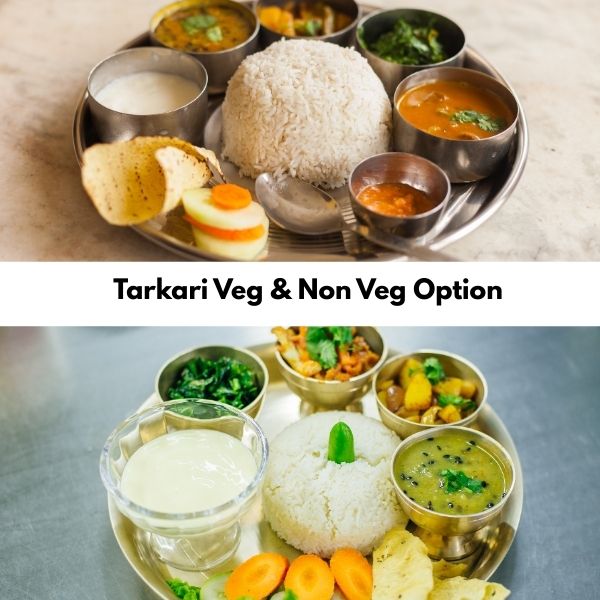
For non-vegetarians, meat such as chicken, buffalo, mutton, pork, and fish is added as a Tarkari in their Dal Bhat dish. Meat is a great source of protein. Additionally, spices like coriander, cumin, and turmeric are used when cooking meat here in Nepal. It adds taste and provides numerous benefits to health.
Dal Bhat Nutrition Profile
Dal Bhat is not just a comfort food but also a balanced meal. Below you can find why Dal Bhat is also called nutritious food.
Calories: A typical serving of dal bhat (with vegetables) contains about 350-450 calories, depending on the portion and specific ingredients used.
Proteins: The combination of lentils and rice provides a complete protein profile, with essential amino acids necessary for body functions.
Fiber: Ingredients high in fiber, like lentils and vegetables, promote digestive health and satiety.
Vitamins and Minerals: Rich in iron, potassium, magnesium, folate, and vitamins A and C from vegetables and spices, contributing to overall health.
Dal Bhat: The Ultimate Fuel for Trekkers
Nepal is a country blessed by God with breathtaking scenery and towering mountains. This region is home to many mountains, including the tallest mountain in the world, Everest. Nepal contains eight of the world’s ten tallest peaks. Not only the mountain, but also the diverse landscape, Rivers, lakes, forests, culture, and traditions attract thousands of trekkers around the globe.
Visiting Nepal is not only for the mountain views but also to know the local traditional Nepali dishes. In every place, you can find your own unique dish prepared by the local people. You may also often hear the trekker slogan “Dal Bhat Power 24 hours,” right?
Yes, due to the nutritional value of Dal Bhat, this simple yet popular dish is also popular among travelers in Nepal. It helps you to nourish your body, whether you are trekking on an easy or demanding trail. When it comes to food, nothing quite compares to the beloved Nepali dish – Dal Bhat.
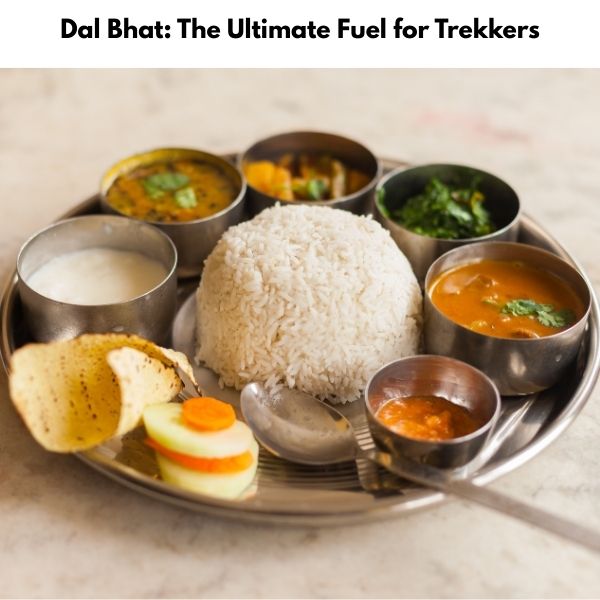
Another best part of Dal Bhat for trekkers is due to its availability. This popular dish can be easily found in tea houses in almost every part of the trekking route. This means trekkers can easily fuel up several times a day without worrying about meal preparation or food availability. Not only is it nutritious, but it is also a budget-friendly dish.
Even though the traditional Dal Bhat meal is standard, depending on the region and locality, you may encounter different variations:
Spicy Versions: In some places, you can find the spicy version of Dal
Different Lentils: Not all Dal is made with the same lentils; you may find variations ranging from yellow lentils to red beans, each offering a unique taste and texture.
Additional Sides: In some locales, you could see specialties like fried fish, a side of curd, or unique local chutneys that elevate the Dal Bhat experience.
Places To Experience Authentic Dal Bhat In Nepal
Home Stay
One of the most well-known travel destinations is Nepal, where thousands of tourists come each year for tours, trekking, hiking, mountain climbing, and other activities. Recent years have seen an increase in the number of visitors staying in homestays and enjoying the outdoors.
They have their own farm and chickens for you to enjoy throughout your stay at home. The best thing about eating Dal Bhat in a homestay is that it’s made with firewood and has excellent flavor.
Thakali Restaurants in Kathmandu & Pokhara
The popular chain restaurant Thakali is located in Nepal’s capital cities of Kathmandu and Pokhara. They are a well-known palace for enjoying the Dal Bhat because of their exceptional service and taste.
A dinner here usually includes a selection of sides, like achar (spicy pickles) and Gundruk (fermented leafy greens). Well-known restaurants like Sangam Restaurant and Thakali Kitchen make your meal unforgettable by serving up wonderful food and celebrating the Thakali way of life.
Bhaktapur Durbar Square
Bhaktapur is a must-visit location in Nepal if you wish to experience Dal Bhat, a traditional Newari cuisine. Here, you may tour the Bhaktapur Durbar area, a UNESCO World Heritage Site, and savor a traditional Dal Bhat dinner at one of the eateries that border the area. Above all, don’t forget to try Juju Dahi, a local handmade yogurt that tastes great with your food.
Trekking Trails
While trekking in the Everest or Langtang regions, like Everest base camp, the Three Passes trek, or the Langtang Valley trek, you can find the basic dal bhat recipe. But if you travel in the Annapurna Region like Gosaikunda, Ghorepani Poon Hill, Annapurna Circuit, or Annapurna Base camp, you can find a wide variety of Dal Bhat recipes prepared by the local families.
Local Markets
In the bustling streets of Kathmandu, Bhaktapur, Lalitpur, Pokhara, and other parts of Nepal, you can find various street vendors selling quick bites of Dal Bhat. Although they don’t have a wide variety, they pair Dal Bhat with fresh vegetables and local homemade achar for fulfilling street food adventures.
Cultural Festivals and Local Celebrations
Nepal is rich in culture and traditions, so every month features different festivals, making it a great opportunity to taste authentic Dal Bhat. Events such as Dashain & Tihar, families come together to prepare traditional meals and share them with neighbors and friends. It also helps to keep bonding between the families and relatives, including visitors.
Must-Try Nepali Dishes to Enjoy Alongside Dal Bhat in Nepal
Momo

Dumplings filled with meat or vegetables, steamed or fried, and often served with spicy chutney. Along with the Dal Bhat, it is one of the famous foods in Nepal. This fast food is easily available in most places. It is one of the most loved foods and the best-selling fast food in Nepal.
Newari Dish
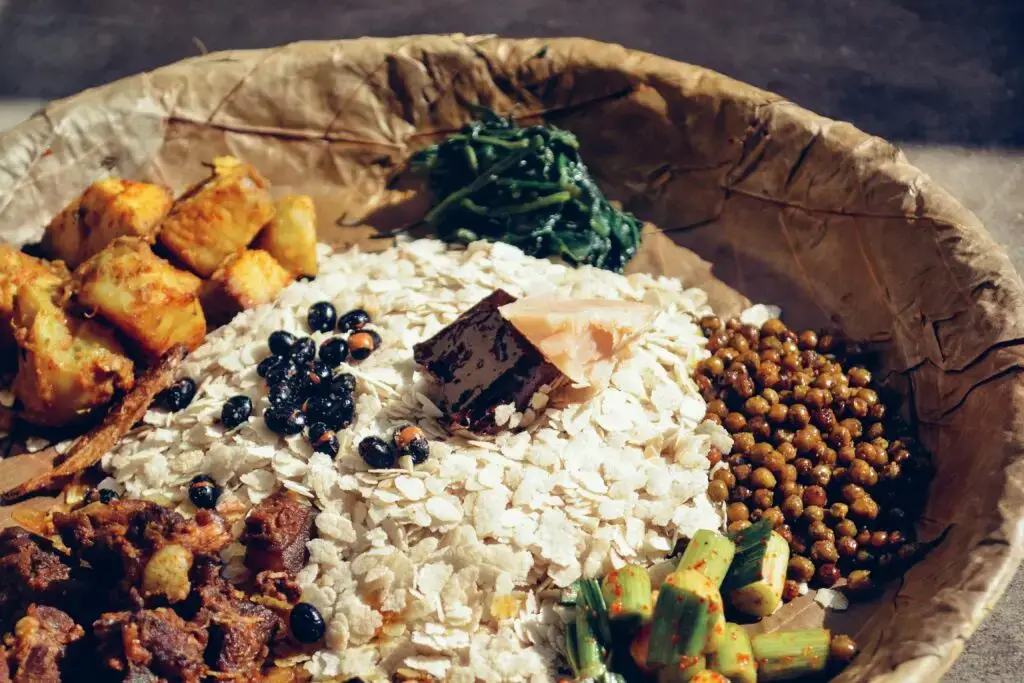
Traditional cuisine from the Newar community in Nepal is known for its rich flavors and unique dishes. There are lots of Newari recipes that you can try when you visit in Nepal. Newari food is mostly spicy in nature. Also, the traditional way of cooking is used in various festivals. Anyone who has ever visited Nepal must try this Newari food. The best place to try Newari Food is in the streets of Bhaktapur and Lalitpur.
For your information, you can try the Newari food in the streets of Hadigaun, where you can see local Newari people selling local food on the street. You can taste what happens every Saturday at a street food festival.
Sekuwa
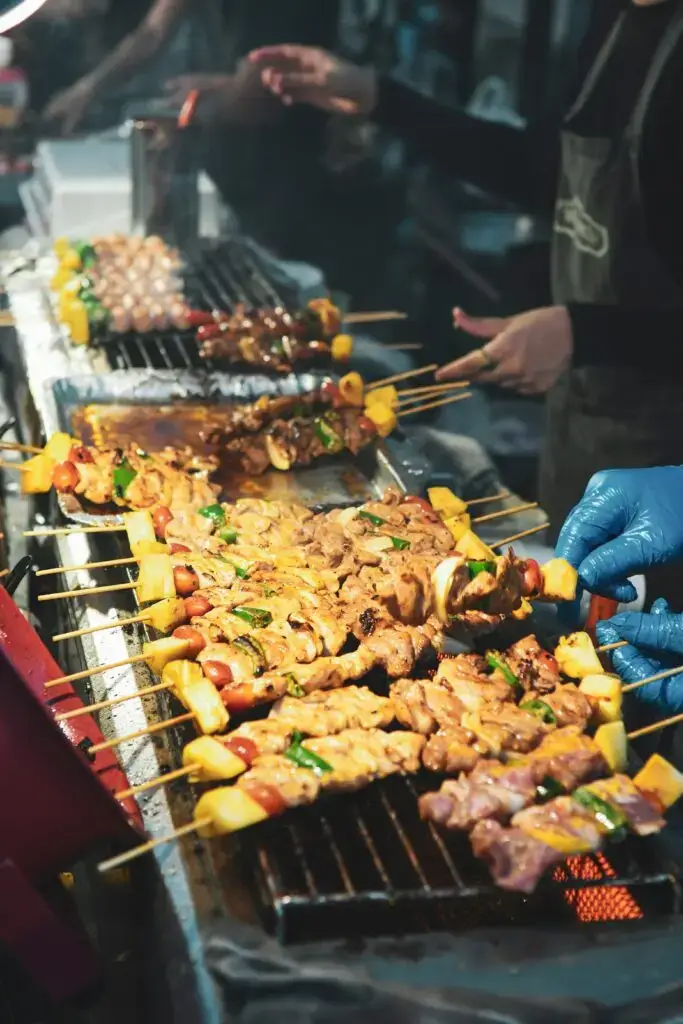
If you are a meat lover, then you must try this Newari item. A popular Newari dish consisting of skewered and grilled marinated meat, typically seasoned with spices and herbs for a smoky, flavorful experience. Also, if you want to try this in a restaurant, we recommend that you try this food in the Bajeko Sewka restaurant.
Chhaang or Raksi ( Local Beverage)
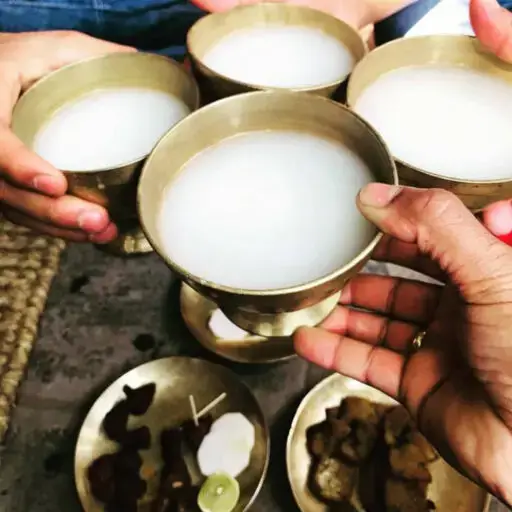
Traditional Nepali alcoholic beverages: Chhaang is a millet-based brew with a slightly sour taste, while Raksi is a distilled spirit made from barley, rice, or millet, known for its strong flavor and cultural significance. You can easily find this Newari local beverage in the Newari restaurant.

